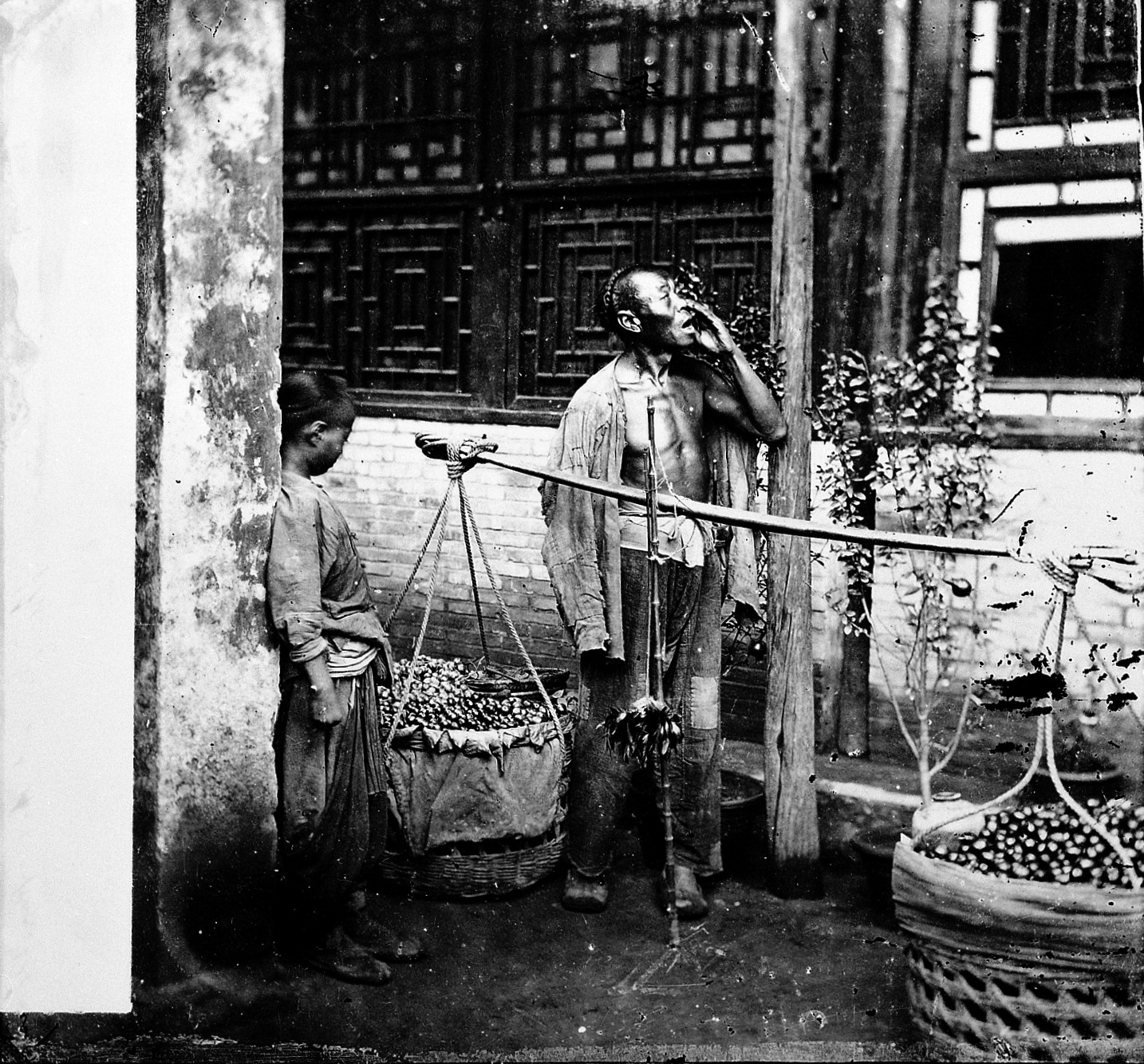|
Peddler
A peddler (American English) or pedlar (British English) is a door-to-door and/or travelling vendor of good (economics), goods. In 19th-century United States the word "drummer" was often used to refer to a peddler or traveling salesman; as exemplified in the popular play ''Sam'l of Posen; or, The Commercial Drummer'' by George H. Jessop. In England, the term was mostly used for travellers hawker (trade), hawking goods in the countryside to small towns and villages. In London, more specific terms were used, such as costermonger. From antiquity, peddlers filled the gaps in the formal market economy by providing consumers with the convenience of door-to-door service. They operated alongside town markets and fairs where they often purchased surplus stocks which were subsequently resold to consumers. Peddlers were able to distribute goods to the more geographically-isolated communities such as those who lived in mountainous regions of Europe. They also called on consumers who, for w ... [...More Info...] [...Related Items...] OR: [Wikipedia] [Google] [Baidu] |
Hawker (trade)
A hawker is a vendor of merchandise that can be easily transported; the term is roughly synonymous with costermonger or peddler. In most places where the term is used, a hawker sells inexpensive goods, handicrafts, or food items. Whether stationary or mobile, hawkers often advertise by loud street cries or chants, and conduct banter with customers, to attract attention and enhance sales. Definition A hawker is a type of street vendor; "a person who travels from place-to-place selling goods." Synonyms include huckster, peddler, chapman or in Britain, costermonger. However, hawkers are distinguished from other types of street vendors in that they are mobile. In contrast, peddlers, for example, may take up a temporary pitch in a public place. Similarly, hawkers tend to be associated with the sale of non-perishable items such as brushes and cookware while costermongers are exclusively associated with the sale of fresh produce. When accompanied by a demonstration or detailed explanati ... [...More Info...] [...Related Items...] OR: [Wikipedia] [Google] [Baidu] |
Sam'l Of Posen; Or, The Commercial Drummer
''Sam'l of Posen; or, The Commercial Drummer'' is a play by the Irish-born dramatist George H. Jessop. Described as a "comic melodrama", the play is regarded as the first work in the history of American theatre to present a positive portrayal of a Jewish character. The character of the Jewish immigrant traveling salesman Samuel Plastrick was created out of a style of humor that originated among Jewish comedians in American music halls, and was the first Jewish character in an English-language play that invited audiences to laugh with a Jewish character rather than at them; a concept which was highly successful in the United States from the play's inception in 1881 but which was ridiculed by critics and audiences when the play was first performed in England. While progressive for its time, the role has also been criticized for introducing a stereotype of a particular type of Jewish character into the literary canon. The role of Samuel Plastrick brought both fame and fortune to the ... [...More Info...] [...Related Items...] OR: [Wikipedia] [Google] [Baidu] |
Itinerant Groups In Europe
There are a number of traditionally itinerant or travelling groups in Europe. The origins of the indigenous itinerant groups are not always clear. The largest of these groups are the Romani people (also ''Roma'' or ''Gypsies'', the latter being increasingly taken as derogatory). They left India around 1,500 years ago, entering Europe around 1,000 years ago via the Balkans. They include the Sinti, Sinti people, who are themselves the second largest group. ''Travellers'', assumed to have taken up the travelling lifestyle out of necessity at some point during the early modern period, are unrelated to the Romani, and assumed to not be ethnically distinct from their source population. However, recent DNA testing has shown that the Irish Travellers are of Irish origin but are genetically distinct from their settled counterparts due to social isolation, and more groups are being studied. The third largest group in Europe is the Yenish people, Yenish, an indigenous Germanic peoples, Germ ... [...More Info...] [...Related Items...] OR: [Wikipedia] [Google] [Baidu] |
Door-to-door
Door-to-door is a canvassing technique that is generally used for sales, marketing, advertising, evangelism or campaigning, in which the person or persons walk from the door of one house to the door of another, trying to sell or advertise a product or service to the general public or gather information. People who use this sales approach are often known as ''traveling salesmen'', or by the archaic name ''drummer'' (someone who "drums up" business), and the technique is also sometimes called '' direct sales''. A variant of this involves cold calling first, when another sales representative attempts to gain agreement that a salesperson should visit. Historically, this was a major method of distributing goods outside large towns, with the salesmen, often self-employed, known as pedlars, peddlers, or hawkers. With the huge growth of retail shops in the 19th century, it became less important, and the development of mail order and finally sales via the internet gradually reduc ... [...More Info...] [...Related Items...] OR: [Wikipedia] [Google] [Baidu] |
John Stuart Mill
John Stuart Mill (20 May 1806 – 7 May 1873) was an English philosopher, political economist, politician and civil servant. One of the most influential thinkers in the history of liberalism and social liberalism, he contributed widely to social theory, political theory, and political economy. Dubbed "the most influential English-speaking philosopher of the nineteenth century" by the ''Stanford Encyclopedia of Philosophy'', he conceived of liberty as justifying the freedom of the individual in opposition to unlimited state and social control. He advocated political and social reforms such as proportional representation, the emancipation of women, and the development of labour organisations and farm cooperatives. The ''Columbia Encyclopedia'' describes Mill as occasionally coming "close to socialism, a theory repugnant to his predecessors". He was a proponent of utilitarianism, an ethical theory developed by his predecessor Jeremy Bentham. He contributed to the investigation ... [...More Info...] [...Related Items...] OR: [Wikipedia] [Google] [Baidu] |
Cart
A cart or dray (Australia and New Zealand) is a vehicle designed for transport, using two wheels and normally pulled by draught animals such as horses, donkeys, mules and oxen, or even smaller animals such as goats or large dogs. A handcart is pulled or pushed by one or more people. Over time, the word "cart" has expanded to mean nearly any small conveyance, including shopping carts, golf carts, go-karts, and Side by Side (UTV), UTVs, without regard to number of wheels, load carried, or means of propulsion. History The history of the cart is closely tied to the Wheel#History, history of the wheel. Carts have been mentioned in literature as far back as the second millennium B.C. The first people to use the cart may have been Mesopotamians. Handcarts pushed by humans have been used around the world. Carts were often used for judicial punishments, both to transport the condemned – a public humiliation in itself (in Ancient Rome defeated leaders were often carried in the vic ... [...More Info...] [...Related Items...] OR: [Wikipedia] [Google] [Baidu] |
Fortune-telling
Fortune telling is the spiritual practice of predicting information about a person's life. Melton, J. Gordon. (2008). ''The Encyclopedia of Religious Phenomena''. Visible Ink Press. pp. 115–116. The scope of fortune telling is in principle identical with the practice of divination. The difference is that divination is the term used for predictions considered part of a religious ritual, invoking deities or spirits, while the term fortune telling implies a less serious or formal setting, even one of popular culture, where belief in occult workings behind the prediction is less prominent than the concept of suggestion, spiritual or practical advisory or affirmation. Historically, Pliny the Elder describes use of the crystal ball in the 1st century CE by soothsayers (''"crystallum orbis"'', later written in Medieval Latin by scribes as ''orbuculum''). Contemporary Western images of fortune telling grow out of folkloristic reception of Renaissance magic, specifically ass ... [...More Info...] [...Related Items...] OR: [Wikipedia] [Google] [Baidu] |
Healer (alternative Medicine)
Alternative medicine refers to practices that aim to achieve the healing effects of conventional medicine, but that typically lack biological plausibility, testability, repeatability, or supporting evidence of effectiveness. Such practices are generally not part of evidence-based medicine. Unlike modern medicine, which employs the scientific method to test plausible therapies by way of responsible and ethical clinical trials, producing repeatable evidence of either effect or of no effect, alternative therapies reside outside of mainstream medicine and do not originate from using the scientific method, but instead rely on testimonials, anecdotes, religion, tradition, superstition, belief in supernatural " energies", pseudoscience, errors in reasoning, propaganda, fraud, or other unscientific sources. Frequently used terms for relevant practices are New Age medicine, pseudo-medicine, unorthodox medicine, holistic medicine, fringe medicine, and unconventional medicine, with litt ... [...More Info...] [...Related Items...] OR: [Wikipedia] [Google] [Baidu] |
Performing Arts
The performing arts are arts such as music, dance, and drama which are performed for an audience. They are different from the visual arts, which involve the use of paint, canvas or various materials to create physical or static art objects. Performing arts include a range of disciplines which are performed in front of a live audience, including theatre, music, and dance. Theatre, music, gymnastics, object manipulation, and other kinds of performances are present in all human cultures. The history of music and dance date to pre-historic times whereas circus skills date to at least Ancient Egypt. Many performing arts are performed professionally. Performance can be in purpose-built buildings, such as theatres and opera houses; on open air stages at festivals; on stages in tents, as in circuses; or on the street. Live performances before an audience are a form of entertainment. The development of audio and video recording has allowed for private consumption of the performin ... [...More Info...] [...Related Items...] OR: [Wikipedia] [Google] [Baidu] |
Yeniche (people)
The Yenish (; , ) are an itinerant group in Western Europe who live mostly in Germany, Austria, Switzerland, Luxembourg, Belgium, and parts of France, roughly centered on the Rhineland. The origins of the Yenish are unknown, though a number of theories for the group's origins have been proposed, including that the Yenish descended from members of the marginalised and vagrant poor classes of society of the early modern period, before emerging as a distinct group by the early 19th century. Most of the Yenish became sedentary in the course of the mid-19th to 20th centuries. Name The Yenish people as a distinct group, as opposed to the generic class of vagrants of the early modern period, emerged towards the end of the 18th century. The adjective is first recorded in the early 18th century in the sense of " cant, argot". A self-designation is recorded in 1793. remained strictly an adjective that refers to the language, not the people, until the first half of the 19th centur ... [...More Info...] [...Related Items...] OR: [Wikipedia] [Google] [Baidu] |
Romani People
{{Infobox ethnic group , group = Romani people , image = , image_caption = , flag = Roma flag.svg , flag_caption = Romani flag created in 1933 and accepted at the 1971 World Romani Congress , pop = 2–12 million , region2 = United States , pop2 = 1 million estimated with Romani ancestry{{efn, 5,400 per 2000 United States census, 2000 census. , ref2 = {{cite news , first=Kayla , last=Webley , url=http://content.time.com/time/nation/article/0,8599,2025316,00.html , title=Hounded in Europe, Roma in the U.S. Keep a Low Profile , agency=Time , date=13 October 2010 , access-date=3 October 2015 , quote=Today, estimates put the number of Roma in the U.S. at about one million. , region3 = Brazil , pop3 = 800,000 (0.4%) , ref3 = , region4 = Spain , pop4 = 750,000–1.5 million (1.5–3.7%) , ref4 = {{cite web , url ... [...More Info...] [...Related Items...] OR: [Wikipedia] [Google] [Baidu] |







